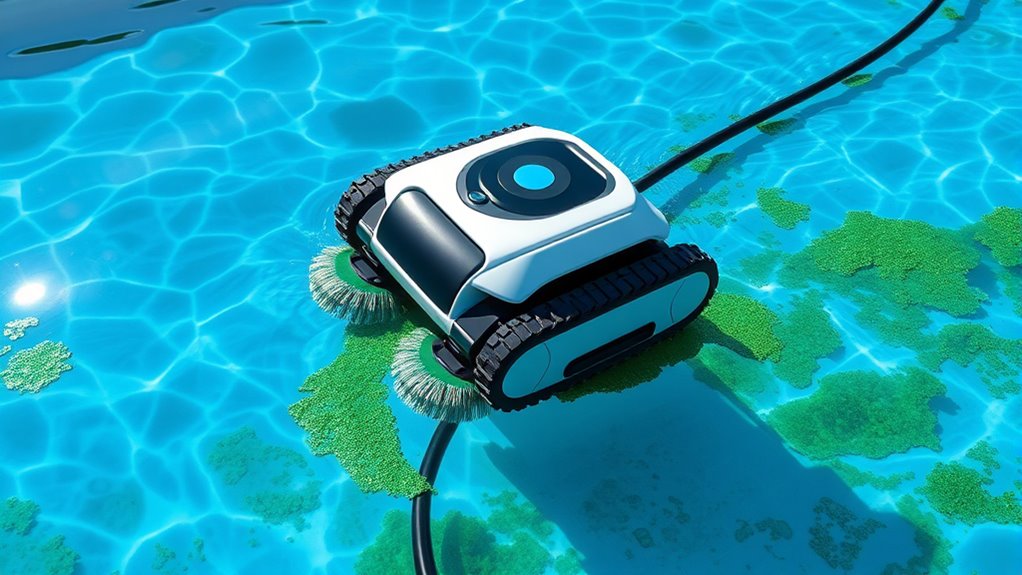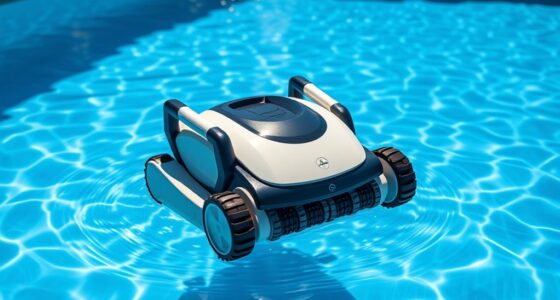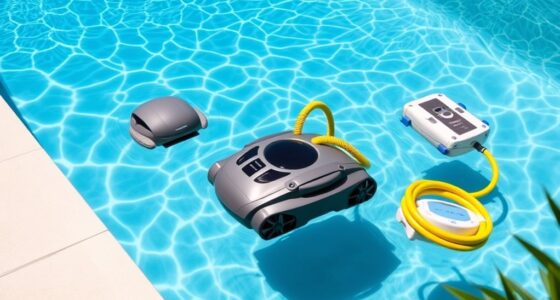Automatic pool cleaners are great at removing debris and dirt, but they can’t directly fight algae or clear cloudy water on their own. They help maintain overall cleanliness but don’t eliminate algae spores or fix water chemistry issues that cause cloudiness. To keep your pool sparkling, you need to combine them with proper chemical treatments and regular maintenance. For tips on maximizing their effectiveness and keeping your pool crystal clear, keep exploring these essential pool care strategies.
Key Takeaways
- Automatic pool cleaners effectively remove debris but do not eliminate algae or treat water chemically.
- They help improve water clarity by removing particulates but cannot clear cloudy water without chemical aid.
- They are not designed to target algae spores or algae buildup directly.
- Chemical treatments, such as shock and algaecides, are necessary alongside cleaners to control algae.
- Regular maintenance and proper chemical balance are essential for clear, algae-free pools.
How Automatic Pool Cleaners Work and Their Limitations

Automatic pool cleaners operate by maneuvering the pool’s surfaces and collecting debris with built-in brushes, filters, or vacuums. They rely on robotic navigation systems to map and navigate the pool efficiently, covering surfaces systematically. This technology helps guarantee thorough cleaning without manual effort. However, their filter efficiency can be a limiting factor, especially when dealing with fine particles or algae spores. If the filter isn’t designed to trap smaller debris, the cleaner may leave some dirt behind, reducing overall cleanliness. While these devices are effective for routine cleaning, they often struggle with more stubborn problems like algae buildup or cloudy water, which require specialized treatments beyond what the cleaner can handle. Understanding these limitations helps set realistic expectations for automatic pool cleaners. Additionally, certain models are better equipped to handle algae and cloudy water than others, emphasizing the importance of choosing the right device for specific pool conditions. Incorporating advanced filtration systems can improve their ability to manage finer debris and improve overall water clarity.
The Challenges of Algae Growth and Cloudiness in Pools
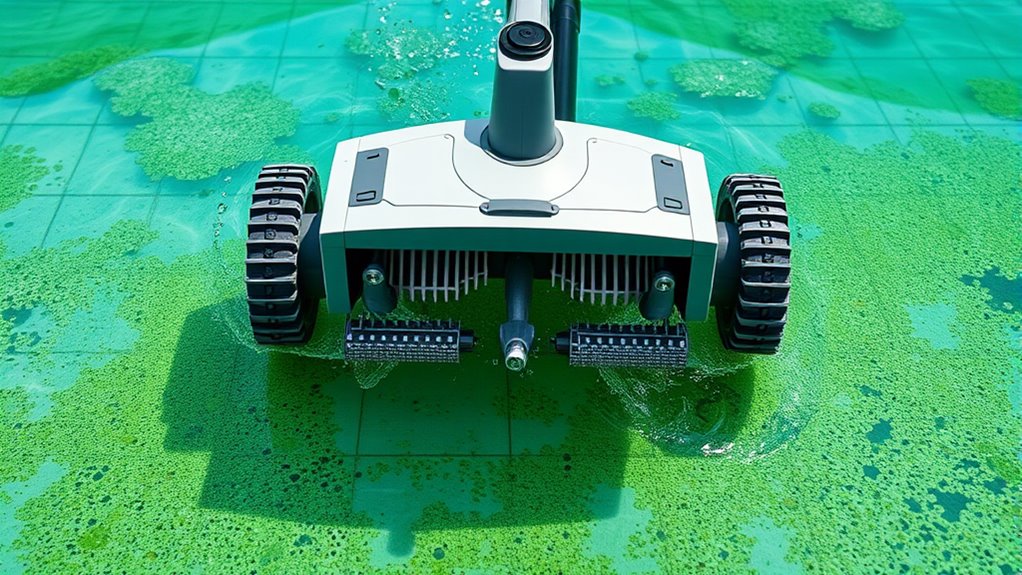
Algae growth and cloudy water pose common yet challenging issues for pool owners, often requiring more than routine cleaning to resolve. You need to maintain proper pool chemical balance, which inhibits algae and clarifies water. Poor chemical levels can lead to algae blooms and persistent cloudiness. Additionally, inadequate filter maintenance allows debris and algae spores to circulate, worsening water quality. To combat these issues effectively, focus on:
Maintaining proper chemical balance and filter care is key to preventing algae and cloudy water.
- Regularly testing and adjusting chemicals, especially chlorine and pH.
- Ensuring your filter is clean and functioning correctly.
- Shock treating the pool when algae appears.
- Brushing pool surfaces to remove algae buildup.
- Proper filter maintenance is essential, as it prevents the circulation of algae spores and debris that can cause cloudiness. Regular filter cleaning also contributes to maintaining optimal water clarity and overall pool health. Using a skimmer or vacuum can help remove surface debris and algae spores, supporting clearer water. Addressing these factors helps prevent algae and cloudiness, making your pool cleaner and safer. While automatic pool cleaners can assist in debris removal, they often aren’t enough without proper chemical and filter management for algae control. Additionally, maintaining a consistent chlorine level helps inhibit algae growth and keep the water clear.
Effectiveness of Different Types of Pool Cleaners in Handling Algae and Cloudiness

Choosing the right pool cleaner can make a significant difference in managing algae and cloudiness. Robotic cleaners excel in efficacy, often reaching areas manual cleaning might miss and consistently removing debris that contributes to cloudiness. They are effective at scrubbing surfaces and filtering fine particles, helping reduce algae buildup over time. Additionally, robotic cleaners often feature advanced filtration systems that enhance their ability to trap microscopic contaminants, further improving water clarity. Effective water circulation is also crucial, as it ensures even distribution of chemicals and prevents stagnation, aiding in algae control. Proper pool maintenance routines, including regular brushing and chemical balancing, can significantly enhance the effectiveness of automatic cleaners. Manual cleaning, on the other hand, offers direct control and can target stubborn algae spots or heavy debris that automatic cleaners might miss initially. While robotic efficacy is impressive, combining it with manual cleaning can enhance overall results, especially in heavily contaminated pools. Different types of cleaners serve various needs, but for algae and cloudiness, a robotic cleaner’s efficiency often provides a more consistent, thorough clean, making it a valuable tool in your pool maintenance arsenal. Additionally, incorporating Mazda Tuning techniques such as suspension and filtration upgrades can inspire ideas for optimizing your pool’s filtration system, leading to even better algae control and water clarity.
Best Practices for Using Automatic Cleaners in Conjunction With Chemical Treatments
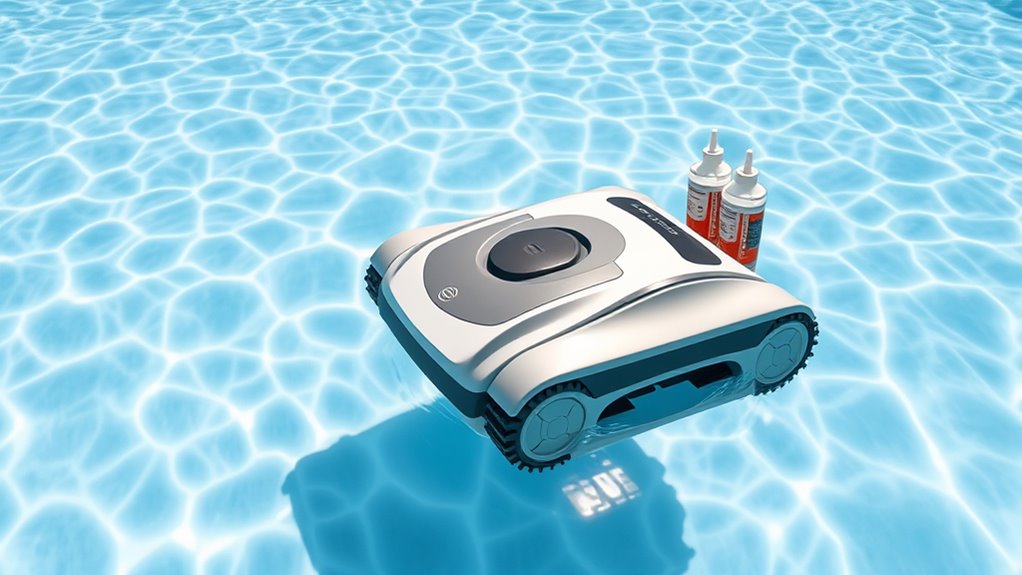
To achieve the best results when cleaning your pool, it is vital to coordinate the use of automatic cleaners with proper chemical treatments. Make certain your pool’s chemical balance is stable before running your robotic cleaner, as incompatible chemicals can damage its components. When selecting a cleaner, prioritize models with advanced robotic navigation to cover the entire pool efficiently. To optimize performance, follow these best practices:
- Test and balance chemicals before cleaning.
- Use chemicals compatible with your robotic cleaner.
- Run the automatic cleaner after chemical treatments have dispersed.
- Regularly inspect and clean the robot’s brushes and filters.
- Consider participating in hackathons to discover innovative pool cleaning solutions or new automation technologies that can enhance your pool maintenance routines. Additionally, understanding the pool chemistry can help prevent issues like algae growth and cloudiness, ensuring your pool remains crystal clear.
Tips for Maintaining a Clear and Healthy Pool Environment
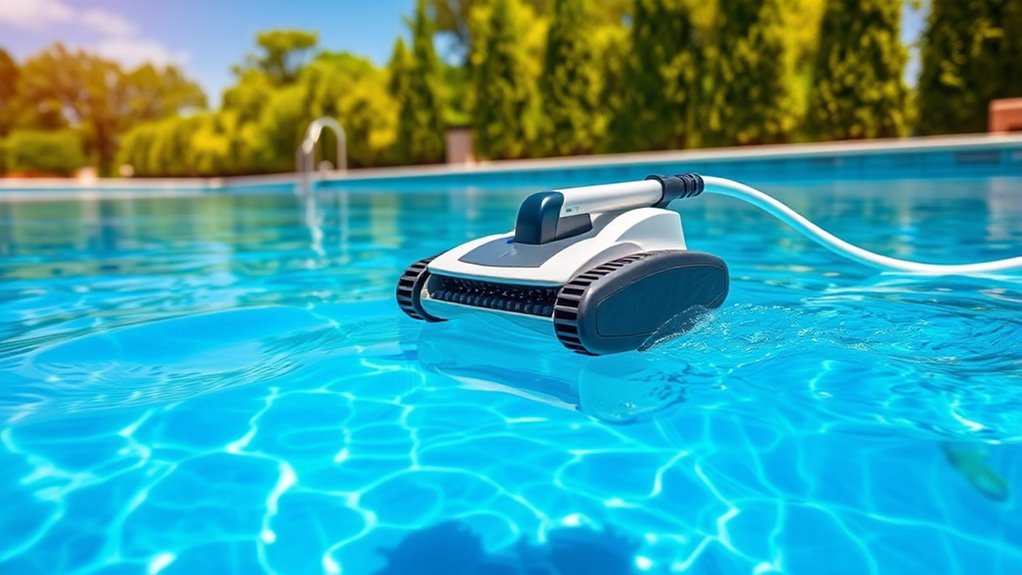
Maintaining a clear and healthy pool environment requires consistent attention to water quality and cleanliness. Proper pool chemistry balances pH, chlorine levels, and alkalinity, preventing algae growth and cloudiness. Ensuring filtration efficiency keeps debris and contaminants out of the water. Regular testing and adjustments are key. Here’s a quick guide:
| Action | Purpose | Frequency |
|---|---|---|
| Test water chemistry | Prevent imbalances | Weekly |
| Clean or replace filters | Maximize filtration efficiency | Monthly |
| Shock the pool | Kill algae and bacteria | Bi-weekly |
| Skim debris | Remove floating debris | Daily |
| Maintain proper circulation | Improve water clarity | Continuous |
Stay consistent, and your pool will stay crystal clear and inviting. Proper maintenance also involves understanding algae control techniques to prevent outbreaks and maintain water clarity. Regularly monitoring chemical levels helps to prevent imbalances, which can contribute to algae growth and cloudiness, and understanding water chemistry is essential for effective pool care. Additionally, paying attention to local environmental factors such as sunlight and temperature can further enhance your pool’s clarity and health. Incorporating automatic pool cleaners into your maintenance routine can help manage debris and reduce manual cleaning efforts, though they may not fully address algae and cloudiness without proper chemical treatment.
Frequently Asked Questions
Can Automatic Pool Cleaners Prevent Algae From Forming Initially?
Automatic pool cleaners help keep your pool clean, but they can’t prevent algae from forming on their own. To stop algae from developing, you need to maintain proper pool chemical balance and regular filter maintenance. Ensuring your chemicals are balanced discourages algae growth, while a clean filter keeps debris out of the water. Combining these steps with your cleaner creates a healthier, clearer pool and reduces algae chances.
How Often Should I Run My Automatic Cleaner During Algae Outbreaks?
Your pool’s cleanliness is a battle you can’t afford to lose—it’s like fighting a flood of algae. During outbreaks, run your automatic cleaner at least daily, ideally twice, to keep debris and algae spores at bay. Maintain proper pool chemistry and stick to your maintenance schedules, ensuring chemicals are balanced. This proactive approach helps clear cloudy water faster and prevents algae from taking over your pool again.
Are Robotic Pool Cleaners Better Than Suction-Side for Algae Removal?
When comparing robotic versus suction-side pool cleaners, robotic models often excel in algae prevention because they scrub surfaces more thoroughly and reach tight spots. They’re better at removing algae from pool walls and floors, making them more effective for algae removal. Suction-side cleaners are more affordable but might struggle with stubborn algae. For ideal algae control, a robotic cleaner is usually the better choice, especially in cloudy or algae-prone pools.
Do Automatic Cleaners Require Special Settings for Cloudy Water?
You don’t usually need special settings on automatic pool cleaners for cloudy water, but proper filter maintenance is essential. Make sure your filter is clean so the cleaner can effectively circulate and pick up debris. Also, maintaining balanced chemicals helps improve water clarity. Regularly check and adjust pH and sanitizer levels, which support the cleaner’s efficiency and keep your pool clearer, even in cloudy conditions.
Can Automatic Cleaners Handle Pools With Heavy Algae Infestation Effectively?
Picture a pool transformed from murky green to crystal clear—automatic cleaners struggle with heavy algae infestations. They excel at removing debris but can’t replace algae prevention or proper chemical balance. To handle algae effectively, you need to regularly treat the water, maintain proper pH, and shock the pool. While cleaners help keep the surface tidy, addressing algae requires proactive chemical management for a truly clean, healthy pool.
Conclusion
While automatic pool cleaners are great for removing debris and dirt, they can’t fully tackle algae and cloudiness on their own. Regular chemical treatments, like algae inhibitors and clarifiers, are essential for a truly clean and clear pool. Did you know that over 60% of pool owners experience algae blooms at least once a season? Combining these treatments with your cleaner guarantees a healthier, sparkling pool all summer long.
